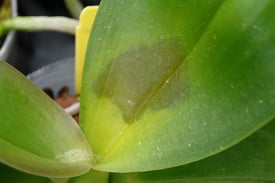
It isn’t the news you wanted to hear about your gorgeous, bright orchids. Bacterial and fungal diseases can strike even hearty orchid species like yours.
When Phalaenopsis orchids are infected by orchid fungal diseases or orchid bacterial diseases, beginning corrective treatment promptly will improve your orchid’s chance of recovery.
Sometimes, the disease or infection could be too widespread, but if you catch it early enough, you may be able to save it!
Two indicators of disease are discolored leaves and an unpleasant odor. Bacterial orchid diseases are caused by high temperatures and high humidity and usually have an obvious visual presentation. If a daily inspection of your plant reveals brown or soft spots; a bacterial disease is the likely culprit.
Bacterial Brown Spot begins as a soft, watery lesion, usually on the orchid’s leaf, that eventually turns brown. In advanced stages, the brown spot will begin to exude a foul-smelling dark liquid. While your orchid’s blooms are bright and stunning and usually the focus of your attention, the leaves are just as essential to your plant’s success, and you must pay attention to their health too!
Bacterial Soft Spot (also called Erwinia) begins as a nasty-smelling wet spot on the orchid’s leaf. The infected area will expand rapidly and within 1 to 2 days the entire leaf will become soft and slimy. Just like we said above, pay attention to your leaves’ health, it will give you great insight into how well the plant is doing.
This is one of the most common and dangerous orchid fungal diseases. At its beginning, orchid owners may notice a subtle discoloration at the center of the plant or at the base, where all the leaves intersect. Crown rot is caused by a combination of overwatering, poor air circulation, and low temperatures. If untreated, plants can die within a week.
This is why we recommend moderate temperatures and moderate watering; the combination of cooler temperatures and too much water won’t set up your plant for success.
Immediately remove infected foliage using a sterilized razor or pair of scissors. Relocate your orchid to expose it to better air circulation, lower humidity, and temperatures between 65 and 80 degrees. Spray your orchid with a good quality, broad-spectrum fungicide, following package directions. Even if you suspect a bacterial disease, fungicide application will prevent secondary infection.
The next time you find yourself dealing with a pesky orchid fungus or bacterial infection, the answer to your problem might not be at your local garden center—it’s probably right in your home. While there are times when stronger stuff is needed, we like to try more natural remedies where possible.
Believe it or not, the contents of your medicine cabinet or pantry can be used to treat orchid fungus. That’s because many herbal remedies have natural anti-fungal or anti-bacterial properties that can help protect against common orchid diseases.
Not only does it taste and smell good, but cinnamon is also a natural fungicide, which makes it useful for protecting your plant from orchid fungus and bacteria.
After you have trimmed your orchid’s leaves or stems, sprinkle a little dusting of cinnamon over the areas. You can sprinkle the seasoning over the area you’d like treated or dip the area directly into some cinnamon. Just make sure the areas you’re sprinkling have been moistened to help the powder stick.
This common household staple is good for sterilizing things or cleaning wounds, and it can help rid your plant of insects. Several types of bugs can infest your orchid, hatching and hiding in tiny nooks and crannies on the leaves, leaving behind a sticky substance and chewing through your plant.
Often horticultural oil or insecticidal soaps are recommended to treat an infestation, but if you don’t have any on hand, try isopropyl alcohol.
Dip your fingers, a cotton ball, or a cotton swab in the alcohol and remove any bugs you see. Continue treatment by spraying alcohol on the plant and to make sure you’ve gotten all the pests, pay particular attention to any crevices, folds, or lips on your plant or pot.
It can do wonders for the health of your mouth, and it can help fight bacterial orchid infections and keep insects from invading your orchid.
Spray directly onto the affected area of the orchid and let sit for five minutes. Then tip the orchid so the remaining liquid drains off. You can also spray your orchid once a week to prevent any insect infestations. Be sure to only use the unflavored version of the mouthwash, as the flavored versions have extra additives that may be harmful to your orchid’s health.
Orchid fungus and infections are no fun, but luckily, they're easy to treat with natural remedies like these.
Check your cabinets. You might just find you have everything you need for orchid care and maintenance right inside.
For more orchid care tips, check out our complete guide to orchid care.

Copyright Just Add Ice® Orchids 2023